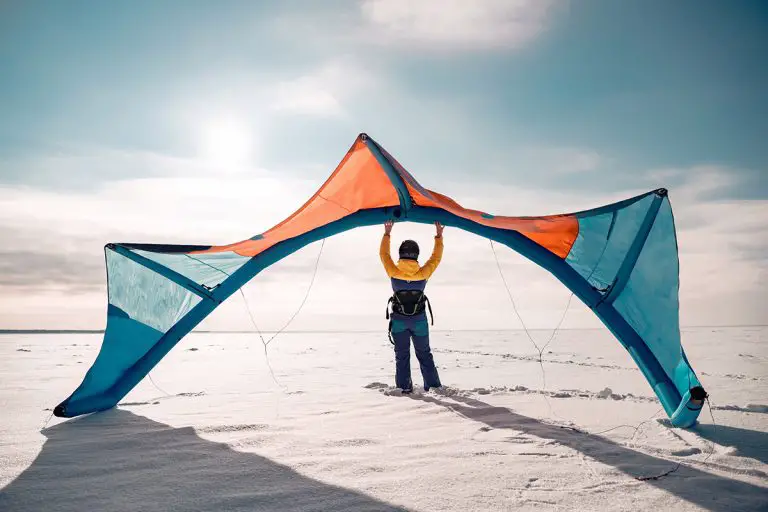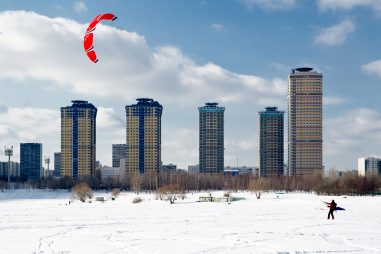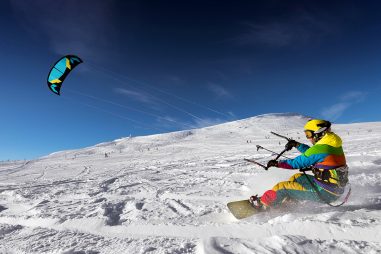Snowkiting’s growing popularity has been attracting many new riders who want to experience the sport’s unique rush. But you’ll need to be well-equipped before you can fly and cruise on ice and snow.
People always say that you need to learn how to walk before you can run. And in snowkiting you’ll need to have the right equipment before you can take flight. With the right equipment and gear, you’ll learn to snowkite properly and safely to minimize the chances of serious injury.
Snowkiting – Skis or Snowboard?
You can use either skis and snowboards for snowkiting. Which one is better is an endless debate for snowkiting enthusiasts. At the end of the day, it’s a matter of preference.
Snowkiting relies heavily on technique and skill over strength. So the first question you have to ask yourself is what are you most familiar with?
If you’re a skier, then you should go for skis. If you’re a snow/water/wakeboarder, then snowboards are for you. Choosing the gear you’re not familiar with will require you to learn like a beginner.
If you’re skilled at both, you’ll want to consider each piece of equipment’s advantages. Skis give you better mobility and control over snow and strong winds. They also have the edge if you want to go at high speeds and longer distances.
Meanwhile, using a snowboard will feel more natural for a board rider. Using a snowboard will give you a smooth and flowing ride which is almost the same as kitesurfing.
Best Skis for Snowkiting
You can use most skis for snowkiting, especially the downhill skis. If you already have one, you should be good to go. However, an all-mountain ski’s versatility is often the preferred choice. They can handle any terrain and various conditions. If you’re in the market for a new ski, here are some of the best ones right now.
- Nordica Enforcer 94: It’s a well-rounded ski that performs well in various conditions and is very responsive. You’ll feel secure and powerful when cruising at different speeds and it gets you on edge fairly easily. It comes in different widths and also has a women’s version available (Nordic Sta. Ana 93).
- Salomon QST 106: Available also at 85mm, the Salomon QST 106 is one of the best when it comes to its capabilities in soft snow. It remains stable in any condition, making it a very versatile option for anyone. If you’re after long-distance snowkite runs, this cruiser is for you.
- Volkl Confession: If you’ll be snowkiting on pure powder snow, the Volk Confession is your ride. It’s designed for cruising on soft snow while preventing you from sinking deeper. The ski doesn’t make quick turns so you won’t accidentally find yourself on undesirable terrain.
In choosing a new ski for snowkiting, you should consider length, width, and side cut.
- Length: Skis that are too long can make it harder to maneuver. If it’s too short, you won’t get the needed support. Ideally, use skis that are a little shorter than the ones you use on the slopes.
- Width: For most terrains, widths of 80-85 mm for women and 80-90mm for men would suffice. These widths allow you to float and maintain an edge on ice or powder snow.
- Sidecut: Skis with small side cuts make it easier to hold your edge.
Best Snowboard for Snowkiting
Unlike skis, there are snowboards made for snowkiting. While they’re similar to waterboards, snowkite boards are designed for the cold and ice. Waterboards will get damaged due to the harder surface (ice) and freezing temperature. Snowboards are also lighter so it will take less effort to float and cruise compared to using waterboards.
But your standard snowboards will also suffice. If you already have one, then you can give it a try before getting a snowkiting board.
When it comes to the best snowboards, take a look at these recommendations:
- NHP Snowkite: Dedicated to snowkiting, the NHP Snowkite performs excellently on ice or snow. This board gives a comfortable ride and a massive pop. You’ll get an extraordinary grip on the toe and heel side for more speed. Expect high-level control and response from its patented Snake Transition. Not using a kite? It’s also a perfect companion for regular snowboarding.
- Jones Stratos Snowboard 2022: This board is an all-around hybrid that excels in every facet of snowboarding. Made by one of the greatest free riders ever, it’s super responsive and lets you execute smooth turns. The Float Pack inserts give it the same float and carving skills that you get from a powder board.
- Salomon Dancehaul 2022: Another all-around snowboard, the Dancehaul performs great on any snow type and terrain conditions. It’s a versatile unisex board that suits any riding style. Expect a lot of float and agility whether you’re in the park or the mountains.
When choosing a snowboard, length and width matter as well.
Longer boards are made for speed but sacrifice maneuverability. Shorter boards have more maneuverability, ideal for terrain park rides. Mid-length boards are more versatile and can handle various speeds and terrains.
Board width will depend on your boot size. A narrow board that won’t fit your boot will result in heel or toe drags. With wide boards, you get more float on powder but allow less maneuverability.
Other things you need to consider are your skills, riding styles, and terrain.
Best Splitboard for Snowkiting
Splitboards are snowboards that can be split into two and be used as skis. So you have the option to use it either as a ski or a snowboard for snowkiting, whichever you prefer.
If you already have a splitboard you often use, then you can stick with that for snowkiting. When choosing a splitboard, you’ll have the same considerations as a snowboard. Want a new one? Check out the highly rated splitboards right now:
- Burton Family Tree Hometown Hero: This board is for those who prefer a freeride board that’s very directional, prefer one riding orientation but still have an aggressive ride. It’s not a speed demon but it can handle moderate speeds with good maneuverability. If you like carving, you’ll be delighted with the deep and aggressive carves this board can offer.
- Jones Solution: It’s a splitboard that can do it all. Its versatile performance is consistent in various terrain and conditions. If you want to go hard and fast on your kite, you’ll be confident riding Jones Solution. Its light weight allows you to maneuver easily, which is more pronounced in friendly environments.
- Weston Backwoods Carbon: Here you have a well-balanced board that has great handling from deep powder snow to backcountry rides. Its carbon material makes it one of the lightest boards around. And despite the bad reviews that carbon gets, the Weston Backwoods offers excellent overall performance and durability.
What Size Kite to Use for Snowkiting?
The kite size you need to use will depend on your body weight and your skill level. Below are the different kite sizes and the general usage guidelines.
- 2m to 3.5m: The smallest size is also called a trainer kite. It’s ideal for anyone who weighs 90 to 120 pounds and is learning to snowkite for the first time. It’s good for moderate winds of up to 18 mph. Because it’s smaller, beginners will be able to handle the wind’s speed and power without the risk of getting carried away or losing control.
- 4m to 6m: This size is still considered a training kite but for bigger people who weigh 140 to 225 pounds. It’s good for starting on light winds to advancing to moderate wind strength. It’s recommended that you take snowkiting lessons with this kite size. This will help beginners progress to the next level.
- 7m to 9m: This is the entry-level kite size for those who already learned the basic kiting and riding skills. You’ll be able to fully engage in snowkiting with this size and allow intermediate riders to progress further. This size lets you enjoy a broad range of wind speeds for more hang time and flight.
- 10m to 15m and above: It’s the most common size that intermediate and advanced snow kiters use. It has a wider wind range so you can cruise at high speeds with stronger winds.
Aside from your weight and skill level, you also have to consider your physical fitness level and environmental conditions. Also, it’s highly recommended that you take lessons before using larger kites. This gives you a better understanding of kiteboarding’s nuances to prevent injuries.
Best Kite for Snowkiting
The best kite for snowkiting depends on your budget, skill level, and what your purpose is. There are generally two kites to choose from: Foil and Leading Edge Inflatable (LEI) kites.
Foil kites are multi-celled kites that resemble parafoils. The air that goes through the kite is what allows it to fly. They’re light but are fragile and expensive. Using these kites requires technical understanding that’s why it’s often used by racers and more advanced riders.
An LEI kite has an inflatable structure. As the name suggests, it needs to be inflated before use.
Power kites also have different bridle configurations. Which one you’ll need depends on your skill level.
Fixed Bridle Kites
- Have a single angle of attack. The physical length and settings can’t be adjusted.
- Often used for beginners.
- Most inexpensive kite option.
- Can be flown with or without a harness.
- Doesn’t allow you to decrease the kite’s power.
De-power Kites
- For intermediate and advanced snowkite riders.
- Comes in two options: foil and leading edge inflatable (LEI).
- Needs additional gear to use.
- Allows you to sheet in and sheet out.
- Considered the safest and smoothest kites.
Here are some of the best snow kites you can buy right now:
- Peter Lynn Skim 4 Trainer Kite: You can use this trainer kite on water and snow. It’s specifically designed to give beginners the ultimate learning experience. It generates enough power for you to train whether you’re on land or water. It also features an effortless re-launch and safety leash system.
- Flysurfer Peak 4: This single-skin foil kite offers agility and power on any terrain. The kite’s main feature is its B-Safe system. It ensures maximum safety while giving you unmatched stability and improved turning and bar feedback. The ultralight feel is perfect for beginners and advanced riders alike. It offers progressive powering and de-powering and more advanced techniques.
- HQ4 Apex: The HQ4 Apex makes it easy to fly. You get maximum control and stability even in difficult wind conditions. The kite offers enough power in the loop for quick reactions to changing winds as well as excellent de-powering output.
- Ozone Explore V2: Made for the expert rider. This lightweight and ultra-compact kite offers high performance despite the light materials. Expect quick inflation, faster flights, and quicker reactions even with low wind speeds. It also features an internal re-ride system that instantly de-powers the kite without tangles.
What Do You Wear for Snowkiting?
Aside from all the equipment mentioned above, you’ll also need to wear protective gear. There’s always the risk of injury given the sports’ extreme nature, and wearing protective gear will make it a much safer experience.
Here are some of the basic gear you need to make snowkiting safe and enjoyable:
- Helmet: Snowkiting can give you big airs. And the higher you fly, the harder you can fall. So it goes without saying that helmets can greatly reduce the chances of head injuries. In Europe and the US, ski and snowboarding helmets need to pass safety standards before being sold in the market. If you’re worried about style, many brands offer stylish helmets to complement your skills.
- Lightly tinted goggles: Snow and other debris can hit you as you cruise on the snow. Goggles protect your eyes from these so you won’t have to fly blind. Also, the tint protects your eyes from harmful UV rays.
- Impact vest/body armor: Your back and torso can be subject to serious injury if left unprotected. There’s always the risk of falls, crashes, and collisions when attempting tricks and advanced moves. There’s also the danger that unfamiliar terrain can bring. Minimize injuries with an impact vest or full body armor.
- Elbow or knee pads: Impact vests and body armors don’t extend to your joints. Elbow and knee pads will lower the risk of serious injuries which can take you out for months. These pads also provide support from the physical strain that your body experiences from extreme sports.
- Snowshoes: You probably won’t be wearing your snowboard on the way to your snowkiting terrain. And in case you need to hike, snowshoes give you the mobility you need.
Where to Buy Snowkiting Equipment
You can buy snowkiting equipment from sporting goods retailers or manufacturers, both online and in-store.
Stores like Dick’s Sporting Goods, Backcountry, and Evo specialize offer various sports equipment. They carry winter clothing, gear, and equipment from many well-known brands. You can find more similar retailers in your area or online.
These stores often have specialists who can help you choose your equipment. They understand what the sport requires and can give you expert advice.
Aside from these retailers, you’ll also find tons of equipment on Amazon. The world’s largest e-commerce market has everything you might need. However, you might have to settle with customer reviews if you want feedback or advice on specific equipment.




